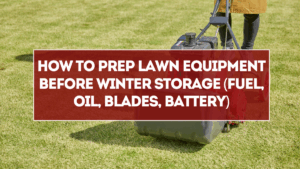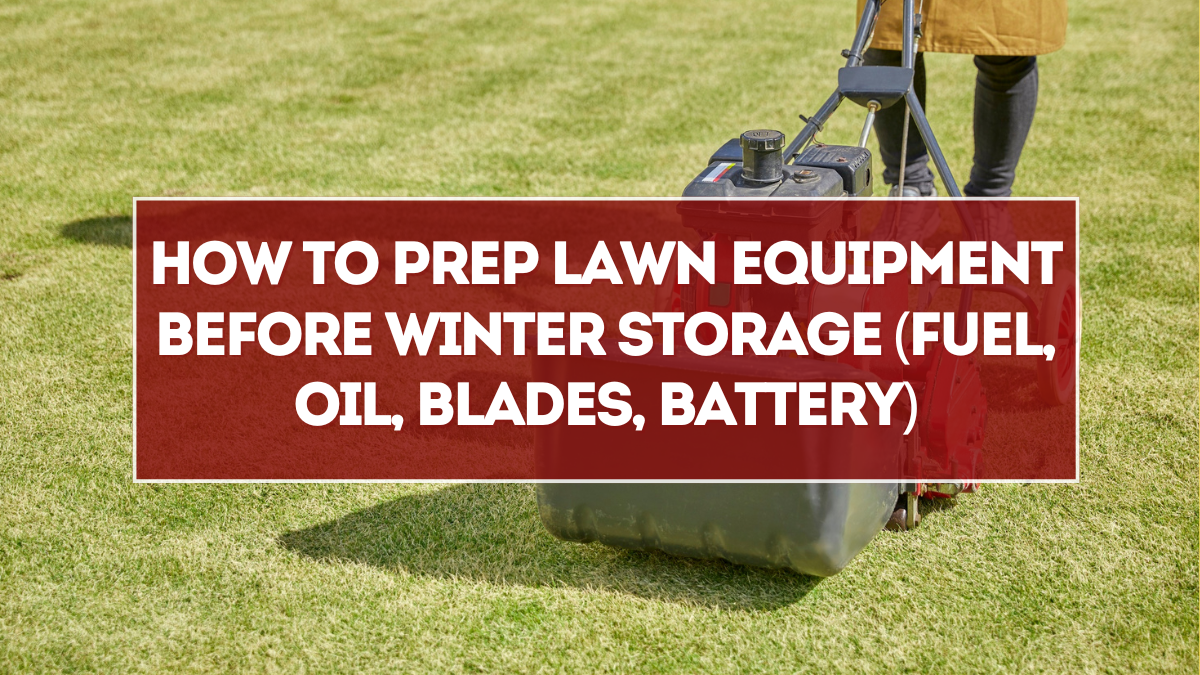As autumn winds down and grass growth slows, it’s tempting to roll your mower into the shed and forget about it until spring. But neglecting proper storage can lead to frustrating problems when you try to start your lawn equipment months later. From clogged carburetors and dead batteries to dull blades and rust, skipping winter preparation costs time, money, and even lawn health.
The good news is that learning how to prep lawn equipment for winter only takes a short afternoon and pays off with a smooth start next season. This guide covers every essential step, including fuel stabilizer use, oil changes, blade sharpening, battery care, and smart storage.

Why Winter Prep Matters
Lawn equipment like mowers, trimmers, and blowers sit unused for months. During that downtime:
-
Fuel degrades and gums up engines.
-
Oil thickens and loses effectiveness.
-
Moisture causes rust in metal parts.
-
Batteries discharge and fail to recharge in spring.
By taking preventive measures now, you extend the life of your tools, save on repairs, and ensure everything starts on the first pull or turn of the key when spring arrives.
Step 1: Deal with the Fuel
Gasoline begins to break down in as little as 30 days, leaving varnish and deposits that clog carburetors. This is the number one reason mowers won’t start in spring.
You have two options:
-
Run the tank dry: Let the engine run until it stops to ensure no fuel is left in the system.
-
Add a fuel stabilizer: If you prefer leaving fuel in the tank, add a stabilizer, run the engine for 5 minutes to circulate it, and then shut it down.
Either method works, but stabilized fuel is ideal if you want to avoid completely emptying the tank.
Step 2: Change the Oil
Old oil contains acids and contaminants that can corrode the engine over winter. A fresh oil change is one of the simplest yet most effective steps.
-
Drain the old oil completely.
-
Refill with the manufacturer-recommended oil type.
-
Dispose of used oil at a recycling center.
Changing the oil not only protects the engine but also ensures smoother starts in spring.
Step 3: Sharpen and Clean Blades
Sharp blades are essential for a clean cut and healthy lawn. Dull or rusty blades tear grass, leaving it vulnerable to disease.
-
Remove mower blades carefully with the proper wrench.
-
Sharpen them with a file or grinder, maintaining the correct angle.
-
Balance the blade to prevent uneven cutting.
-
Reinstall securely before storage.
While blades are off, inspect the underside of the mower deck and scrape off any built-up grass clippings to prevent rust.
Step 4: Clean the Equipment
Before storage, give all equipment a thorough cleaning.
-
Wash off grass clippings, dirt, and debris.
-
Dry completely to prevent rust.
-
Wipe down surfaces with an oily rag or silicone spray for extra protection.
This step is often overlooked but makes a big difference in preventing corrosion.
Step 5: Care for the Battery
If your mower or equipment has a battery, don’t leave it connected all winter. Cold weather drains batteries quickly.
-
Disconnect and remove the battery.
-
Store it in a cool, dry place.
-
Use a trickle charger to keep it topped up during winter months.
This ensures the battery is ready to go in spring instead of being dead and needing replacement.
Step 6: Inspect Belts, Cables, and Filters
Winter is a good time to perform a quick inspection so you’re not surprised later.
-
Check belts for cracks or fraying.
-
Lubricate cables and moving joints.
-
Replace air filters if dirty.
-
Swap out spark plugs if they show signs of wear.
A few preventive checks now save a spring full of frustration.
Step 7: Store Properly
Where and how you store your lawn equipment matters.
-
Choose a dry, covered location like a garage or shed.
-
Keep equipment off the ground using pallets or stands to prevent moisture damage.
-
Cover with a breathable tarp—never plastic, as it traps condensation.
-
Keep tools organized so they are ready to use when needed.
Benefits of Winterizing Lawn Equipment
The time you invest in prepping lawn tools pays off in multiple ways:
-
Extends the lifespan of engines and blades.
-
Prevents costly repairs and replacements.
-
Ensures first-time starts in spring.
-
Improves cutting performance for healthier grass.
-
Saves money by reducing fuel and part waste.
Mistakes to Avoid
-
Storing equipment with untreated fuel, which causes springtime engine problems.
-
Leaving batteries connected in freezing conditions.
-
Covering equipment with airtight plastic that traps moisture.
-
Skipping blade sharpening, which weakens grass the next growing season.
Additional Tools to Prep
While mowers are the main focus, don’t forget other lawn equipment:
-
String trimmers: Clean debris from the head, replace trimmer line, and check spark plugs.
-
Leaf blowers: Empty fuel tanks, clean filters, and inspect tubes for cracks.
-
Chainsaws: Sharpen the chain, drain fuel, and store safely in a case.
Taking the same steps with all tools ensures your entire lawn care arsenal is ready for spring.
Why Proper Prep Protects Your Lawn
Beyond saving your tools, proper winterizing impacts your lawn’s health. A mower that starts easily, runs efficiently, and cuts cleanly sets the tone for the entire season. Poorly maintained equipment struggles, scalps grass, or spreads disease. In other words, caring for your equipment is part of caring for your lawn.
FAQs
Should I run my mower out of gas before winter?
Yes, unless you use a fuel stabilizer. Either method prevents old gas from gumming up the carburetor.
How often should mower blades be sharpened?
At least twice per season, and always before winter storage.
Can I leave my lawn mower outside with a cover?
It’s better to store indoors, but if you must leave it outside, use a breathable, weatherproof cover.
Do I really need to change the oil before winter?
Yes. Fresh oil prevents internal corrosion and helps engines start more easily.
How long will a mower battery last if stored correctly?
With proper care and trickle charging, most batteries last 3–5 years.
Click here to know more.
